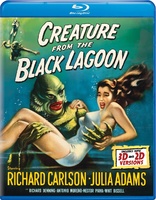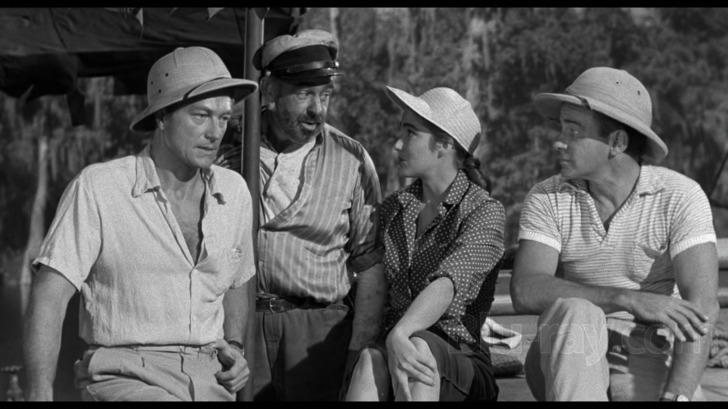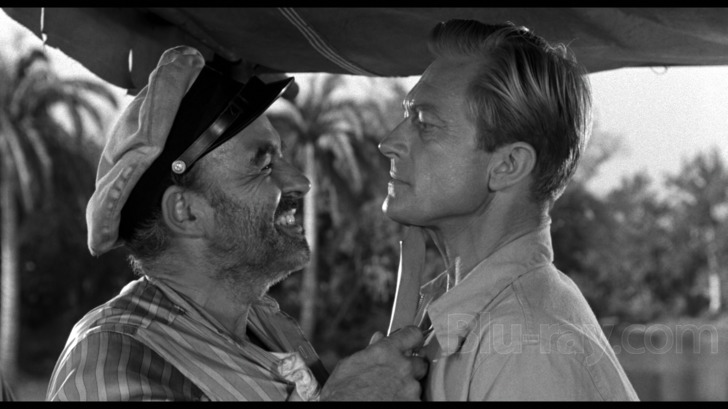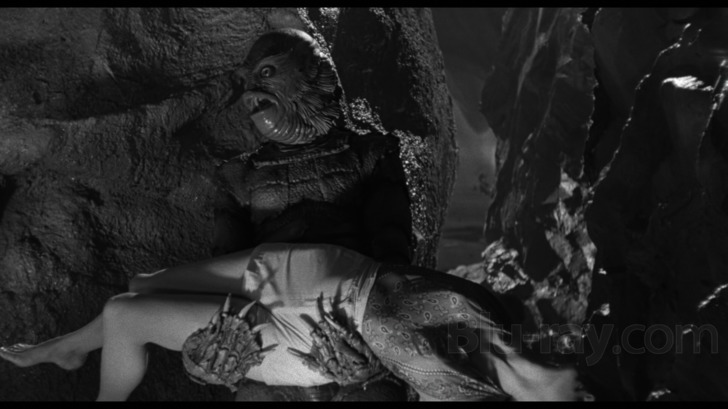Creature from the Black Lagoon 3D Blu-ray Movie
HomeCreature from the Black Lagoon 3D Blu-ray Movie 
Blu-ray 3D + Blu-rayUniversal Studios | 1954 | 79 min | Rated G | Jun 04, 2013

Movie rating
7.4 | / 10 |
Blu-ray rating
| Users | 4.4 | |
| Reviewer | 3.5 | |
| Overall | 3.5 |
Overview
Creature from the Black Lagoon 3D (1954)
In the early 1950s, a scientific expedition into the Amazon recovers a strange fossilized claw that could be a missing link between creatures that swim in the seas and those that walk on land. Once the fossil is examined, a larger, better-funded expedition is authorized to travel deep into the interior of the Amazon Basin to hopefully find more examples of the long dead creature. But as the expedition pushes deeper into the unexplored reaches of the great waterway, they come to the realization that "something" is watching their every move, stalking them... on the land, and in the water!
Starring: Richard Carlson, Julie Adams, Richard Denning, Antonio Moreno (I), Nestor PaivaDirector: Jack Arnold (I)
| Horror | Uncertain |
| Sci-Fi | Uncertain |
| Adventure | Uncertain |
Specifications
Video
Video codec: MPEG-4 MVC
Video resolution: 1080p
Aspect ratio: 1.85:1
Original aspect ratio: 2.00:1
Audio
English: DTS-HD Master Audio 2.0 Mono (48kHz, 24-bit)
French: DTS 2.0 Mono
Subtitles
English SDH, Spanish
Discs
50GB Blu-ray Disc
Single disc (1 BD)
Blu-ray 3D
Playback
Region free
Review
Rating summary
| Movie | 4.0 | |
| Video | 4.0 | |
| Audio | 4.5 | |
| Extras | 2.5 | |
| Overall | 3.5 |
Creature from the Black Lagoon 3D Blu-ray Movie Review
"We didn't come here to fight monsters, we're not equipped for it..."
Reviewed by Kenneth Brown September 28, 2012Take a moment and imagine what modern horror would be without Universal Pictures. Without founder Carl Laemmle and his vision for the future of cinema, or his son Carl Laemmle Jr., who inherited the keys to the studio kingdom in 1928, when talkies were rapidly displacing silent films and promising groundbreaking new strides in moviemaking and the movie-going experience. Without early horror pioneers like Tod Browning, James Whale, Karl Freund, George Waggner or Jack Arnold. Without iconic creature actors Bela Lugosi, Boris Karloff, Claude Rains, Lon Chaney, Jr., Elsa Lanchester or Ben Chapman. Without Dracula, the indispensable 1931 classic that left a more lasting mark on vampire movies and lore than any other vampire film before or after (save Nosferatu). Or Frankenstein, which pushed boundaries, shocked audiences and has been received with overwhelming enthusiasm ever since. The Mummy, bold in its atmosphere and unforgettable in its tragic romance. The Invisible Man, which features some of the most astonishing special effects and perhaps one of the most unnerving depictions of mounting madness of the era. The Bride of Frankenstein, a complex, wickedly funny, altogether unpredictable sequel that in many regards surpasses its predecessor. The Wolf Man, a once-chilling character drama that examines the frailty of man and the beast within. Phantom of the Opera, though more a twisted love story than a traditional horror picture, a film that nevertheless caused some theaters to stock smelling salts in in the event that a moviegoer fainted upon the removal of the Phantom's mask. Or Creature from the Black Lagoon, which frightened audiences above the water and below with a scaly monster unlike any they had seen before. Needless to say, modern horror, and really the genre in whole, would be completely different than what we know.

Creature from the Black Lagoon certainly wasn't the first Universal horror movie inspired by Beauty and the Beast. Many of the films in the Essentials Collection, in fact, owe a debt of gratitude to the age-old story of a monster tamed, however briefly, by love. But the early Universal classics have a knack for humanizing their monsters and making it that much more difficult to feel any sort of elation when the Reaper comes to collect, and Creature is no different. Credit where credit's most due: first to the effects masters who created The Gill Man -- and the two men who donned the suit, underwater performer Ricou Browning and on-land actor Ben Chapman -- and second to the cast who sell the terror: Julia Adams as pretty faced damsel-in-distress Kay Lawrence, Richard Carlson as Dr. David Reed, Antonio Moreno as Dr. Carl Maia, Whit Bissell as Dr. Edwin Thompson, and Nestor Paiva as Lucas (a precursor to Robert Shaw's Quint in Jaws). Creature is notable for more than its leading men, its shrill-shrieking beauty and its amphibious beast, though. Director Jack Arnold is patient and shrewd, the film is paced smartly, and the suspense is worth the price of admission alone. (Count the number of shots and scenes that clearly left an impression on a young Steven Spielberg, and picture Jaws without them.) And then there's Chris Mueller, Jr. and Jack Kevan's Gill Man suit. It not only remains an impressive relic of '50s creature feature cinema, its grasping webbed fingers, bulging throat and pulsing gills still look so... alive. Even fifty-eight years later, closeups of the insatiable monster are the stuff of childhood dreams and Sleestak nightmares, regardless of how much the passage of time has diluted the movie's scares.
Creature from the Black Lagoon 3D Blu-ray Movie, Video Quality 

Creature from the Black Lagoon rises out of the mid-50s muck with a less than ideal restoration, a hit-or-miss 1080p/MVC-encoded video transfer and a slightly problematic (but mostly engaging) native 3D experience. First the restoration. Several inherent issues manifest again and again throughout the film: stretches of soupy and/or chunky grain (most of which trace back to the filmmakers pushing in on the negative and literally increasing the size of each speck of grain), terribly soft shots some will mistake for evidence of egregious noise reduction (which isn't the case here at all), and a general unevenness rooted in the unwieldy condition of the source elements. (Keep in mind, even the most skilled film preservationist can't turn water into wine.) Several more issues, though, aren't inherited from the original film elements: minor ringing, faint and graciously infrequent underwater macroblocking, and slight, almost negligible banding in the bright skies. And then there's the 3D presentation, which comes with hiccups of its own, despite the fact that most of them are easy to overlook. 3D displays and glasses that are prone to ghosting will run into several eyesores, among them POV shots where the Gill Man pushes past jungle underbrush, the backgrounds in dark scenes where the creature stalks Kay at night, and some of the underwater sequences. None of it -- the restoration shortcomings, the transfer/encoding issues or the 3D presentation's woes -- matter all that much. It's when they begin piling up and taking a collective toll.
All that being said, the film still looks quite good; I'd go so far as to say as good as it could considering the various challenges the restoration team appear to have faced. When the sun is up, the cameras are above the water, and the shot is crisp and steady, the transfer follows suit. (Luckily, that's 80% of the movie.) Gray tones are natural, carefully dialed contrast leveling helps the image pop, and blacks are nice and deep. Detail is terrific too... minus those brief, intermittent instances when the original photography falters. The presentation can be a jarring one every now and then, switching between two distinct modes: scenes that make Creature look as if it's been given the same attention and investment as Dracula and other movies in the Essentials Collection, and scenes that make it look inadequate by comparison. The cause obviously isn't that black and white (pardon the pun), as that would imply certain shots and sequences were restored while others were not. (Which is something someone, somewhere will inevitably assume.) Universal has made the best of what I presume was a difficult restoration with very few across-the-board solutions. It's still leagues beyond passable in 2D and 3D (and boasts excellent depth and dimensionality), and it isn't a cut-n-dry achievement or failure, no matter which way subjective opinions lean. This is one that would have definitely benefited from a project-specific restoration featurette a la the one included with Dracula. If nothing else, it would have addressed the presentation's flaws and made it easier to appreciate its finer qualities.
Creature from the Black Lagoon 3D Blu-ray Movie, Audio Quality 

Evaluating Universal's two-channel DTS-HD Master Audio Mono track isn't as challenging, mainly because there's very little to criticize or complain about. Dialogue is direct, intelligible and accurately represented, voices are clean and clear, and sound effects, canned and stagy as any effects of the era, rarely falter. Henry Mancini, Hans J. Salter and Herman Stein's music score runs into the limitations of its original recording, but the film's orchestral arrangements have a fullness that defies mono bounds, blaring trumpets and furious strings sound great, and the persistent, oft-repeated and never-subtle bum bum bwaaaum! that accompanies each appearance of the Gill Man is as piercing and hair-raising as Julia Adams' blood-curdling screams.
Creature from the Black Lagoon 3D Blu-ray Movie, Special Features and Extras 

- Back to the Black Lagoon (SD, 40 minutes): Film historian David J. Skal hosts, the Gill Man rampages, and Creature from the Black Lagoon is dissected, from its inspirations to its development, scripting, production, special effects, makeup and more.
- Audio Commentary: The last of the Essentials commentaries passes the mic to film historian Tom Weaver, who reads from pre-prepared notes and breaks free from his script to interject additional comments, observations and Creature factoids. Weaver does a fine job of painting a full, complete picture of the path to the Black Lagoon, as well as its shoot, release, sequels and legacy.
- 100 Years of Universal: The Lot (HD, 9 minutes): The Universal backlot in all its glory.
- Production Photographs (SD, 11 minutes): Movie posters, campaign art, production stills and other images.
- Trailer Gallery (SD, 7 minutes): Creature from the Black Lagoon, Revenge of the Creature and The Creature Walks Among Us.
Creature from the Black Lagoon 3D Blu-ray Movie, Overall Score and Recommendation 

The Creature of the Black Lagoon is a fitting film to end on. The movie and its amphibious beastie holds up all these years later and represents one of the last great creature features of Hollywood's first major horror boom. The Blu-ray edition is a bit all over the place, though. Its DTS-HD Master Audio Mono mix delivers, while its restoration and video transfer are strong but problematic, its 3D experience suffers a bit too (albeit not too much), and its special features are the slimmest in the Universal Classic Monsters: Essentials Collection. It's still worth owning, don't get me wrong, but I suspect most of you will invest more time elsewhere in the eight-film box set.
Other editions
Creature from the Black Lagoon: Other Editions

Creature from the Black Lagoon 3D
1954

Creature from the Black Lagoon 3D
w/ Glow in the Dark Art
1954

Creature from the Black Lagoon 3D
1954

Creature from the Black Lagoon 4K + 3D
1954

Creature from the Black Lagoon 4K + 3D
1954
Similar titles
Similar titles you might also like

The Invisible Man 4K
1933

The Bride of Frankenstein 4K
1935

It Came from Outer Space 4K + 3D
Universal Essentials Collection
1953

Frankenstein 4K
1931

The Creature Walks Among Us
1956

Revenge of the Creature 3D
1955

House of Frankenstein 4K
1944

The Wolf Man 4K
1941

The Blob
1958

The Blob 4K
1988

The Thing from Another World
Warner Archive Collection
1951

It! The Terror from Beyond Space
2K Restoration
1958

The Quatermass Xperiment
Special Edition | The Creeping Unknown
1955

The Monolith Monsters
1957

Attack of the 50 Ft. Woman
Warner Archive Collection
1958

Fiend Without a Face
1958

From Hell It Came
Warner Archive Collection
1957

The Invisible Man Returns
1940

The Beast from 20,000 Fathoms
1953

The Mummy 4K
1932